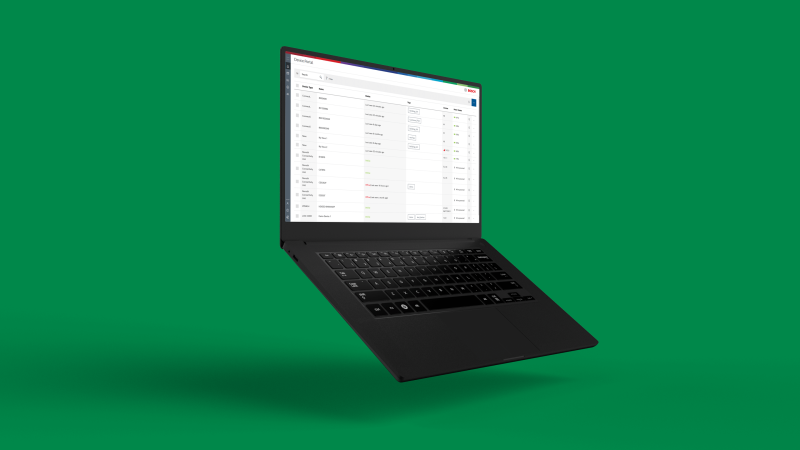Smart device management for industrial applications
How the Device Portal ensures greater security and optimal functionality


IoT devices are enriching many areas of life – and are also playing an increasingly important role in the industrial environment. In order to take full advantage of the technology, manufacturers and suppliers need an IT solution to manage their delivered devices – whether these are industrial machine components or any other connected devices. The Device Portal addresses the greatest challenges of secure remote management and sets the course for data-driven services. In this interview, Emmanuel Guigues, Product Owner of the Device Portal, explains what this means.
Emmanuel, everyone is talking about the Industrial IoT. The customer requirements in terms of connectivity and security of devices are increasing rapidly – but what does that mean for device manufacturers specifically?
Delivering a device with a certain configuration and leaving the rest to the customer is a thing of the past. Device management not only enables companies to improve their productivity and efficiency, it also allows manufacturers to stay connected to their devices throughout their entire life cycle. This opens up new possibilities: Regular updates, error analysis and an efficient support are possible via remote access. If security gaps are detected, these can be closed immediately on the affected devices. In addition, the device manufacturer can conveniently offer additional services over the air.
Of course, some basic requirements must be met for these features to work. As lead provider and lead user, Bosch has developed an IT solution for device management that deals with daily challenges: the Device Portal.
What exactly are the benefits that device manufacturers gain from using the Device Portal?
The Device Portal combines all necessary functionalities for modern device management. It is available to everyone in the cloud as a white-label solution: a device manufacturer only needs to implement the communication between his product and the Device Portal’s public interface (REST API). When selling the device, the manufacturer can then manage his devices himself or allow his customers to do it on their own.
The Device Portal provides a complete overview of all delivered and installed devices: How many and which devices are online or offline? What is their current status? Which software is installed and which version of the software is it? What is their update history? And are there any error messages?
In addition, the usage of the devices can be monitored live and valuable insights for quality monitoring and product development can be gained. In the past, manufacturers only received feedback in the event of a malfunction – the Device Portal creates a new level of transparency.

This new connectivity does not only yield benefits, however – if you think of the vulnerability in Log4j, for instance. How does the software address these security issues, which will most likely become even more serious in the future?
Native applications on connected devices can, of course, have security gaps – these can never be entirely prevented because technologies are evolving quickly and new security issues are discovered worldwide every day. What our solution makes possible is firstly, to identify which devices are impacted and secondly, to roll-out software updates very quickly to a big number of devices. This means that once a security problem is detected, the gap can be closed within a very short time – regardless of whether 10 or 10,000 devices are affected.
The Device Portal follows the very strict security specifications of the Bosch Group. For example, communication with the devices takes place exclusively after authentication by SSL certificate.

We talked about updating devices in the event of security issues, but can you describe another typical use case for your solution?
Let's imagine that a manufacturer has sold his devices to a customer abroad. This customer has difficulty configuring the devices and contacts the service center. Thanks to the Device Portal, the service employees can immediately call up the devices, check all relevant information, and provide support. They can also access each device individually and configure/enter the correct settings themselves. On-site appointments are not required; neither is returning devices. Manual searches for information in printed documents are also not necessary, and language barriers are less likely to lead to misunderstandings. All support can be conveniently carried out remotely. Particularly in challenging times like these, customers demand such cost and resource savers.
Where is the journey taking us in the long term? What will be the use cases of the future?
Cloud solutions for device management enable us to gain extensive insight into their use – with the end customer's consent, of course. Manufacturers can use this information to better design future products and services by taking into account actual customer needs. For example: If a customer has many different devices with different software versions in use, an intelligent alert system could help him avoid missing any more updates. Such additional functions do not necessarily have to come from the manufacturer, either. In the future, third-party providers will be able to offer their data-driven services in a cross-company digital ecosystem – for example, analytics, commissioning or maintenance-as-a-service.
As a device manufacturer, I would like to benefit from the advantages of the Device Portal. What does the process look like?
Our approach is completely individual and depends on the specific use cases of each customer. The first step always consists of a comprehensive meeting in which we will analyze your requirements. Our experts will then support your developers in building a “proof of concept”, where you can verify if our solution matches your expectations. Our pricing is also very attractive, especially for medium-sized companies and start-ups, as we offer a “pay-per-use” model. This low-threshold level entry is ideal as a first step toward digitalizing your product life cycle.
Get in touch with us
Monday – Friday, 9 a.m. – 4 p.m. CET
